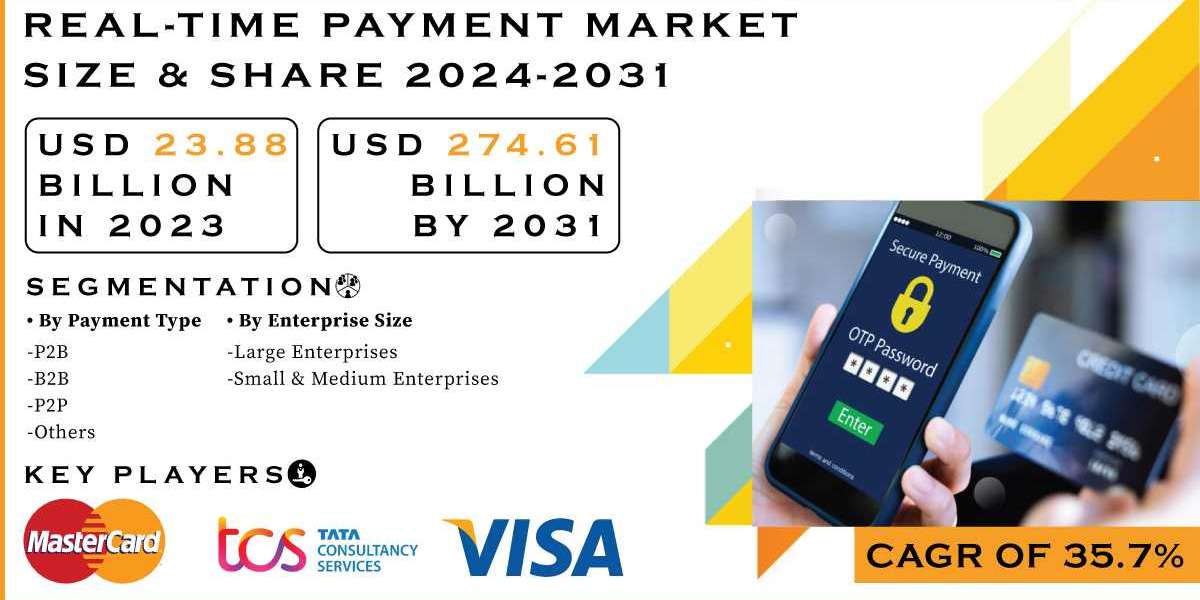Real-Time Payment 2024
Real-time payments (RTP) are reshaping the way financial transactions are conducted, providing a rapid and efficient alternative to traditional payment methods. By enabling instant transaction processing and settlement, RTP systems are revolutionizing both consumer and business payment experiences. This article delves into the evolution of real-time payments, their transformative impact on the financial sector, and the future potential of this innovative technology.
The Evolution of Real-Time Payments
Historically, payment processing involved delays due to batch processing and manual reconciliation. With the rise of digital technology and increasing consumer expectations for immediacy, real-time payments have emerged as a groundbreaking solution. RTP systems leverage advanced technology to ensure that transactions are processed and settled in real-time, offering a seamless and instantaneous payment experience.
Real-Time Payment Market size was USD 23.88 billion in 2023 and is expected to reach USD 274.61 billion by 2031 and grow at a CAGR of 35.7% over the forecast period of 2024-2031.
Transformative Impact on the Financial Sector
Streamlined Payment Processes: Real-time payments streamline payment processes by eliminating delays and reducing the need for manual intervention. This efficiency is particularly valuable for businesses that require quick and accurate transaction processing to maintain operational agility and meet customer demands.
Enhanced Financial Inclusion: RTP has the potential to improve financial inclusion by providing individuals and businesses in underserved regions with access to faster and more reliable payment services. By bridging gaps in traditional financial infrastructure, RTP can promote economic growth and financial empowerment.
Innovation in Payment Services: The adoption of real-time payments fosters innovation in payment services and applications. Financial institutions and fintech companies are exploring new ways to leverage RTP technology, such as integrating it with digital wallets, payment apps, and other financial services to create a more interconnected payment ecosystem.
Economic Efficiency: Real-time payments contribute to overall economic efficiency by accelerating the flow of funds and reducing the costs associated with traditional payment methods. This efficiency benefits both consumers and businesses by facilitating faster transactions and improving cash flow management.
Support for New Business Models: RTP enables the development of new business models and revenue streams. For example, businesses can offer instant refunds, real-time disbursements, and immediate access to funds, enhancing their value proposition and competitiveness in the market.
Challenges in Real-Time Payment Implementation
Integration Complexity: Integrating real-time payment systems with existing financial infrastructure can be complex and resource-intensive. Organizations must address technical challenges, ensure compatibility with legacy systems, and manage the transition to real-time processing.
Regulatory and Compliance Issues: Real-time payments are subject to various regulatory and compliance requirements. Financial institutions and payment providers must navigate complex regulatory landscapes to ensure adherence to legal standards and protect against potential risks.
Data Privacy and Security: The speed of real-time payments necessitates robust data privacy and security measures. Organizations must implement strong encryption, fraud detection, and data protection protocols to safeguard sensitive financial information and prevent security breaches.
Market Fragmentation: The real-time payment market can be fragmented, with different systems and networks operating in various regions. Efforts are needed to achieve global interoperability and create a unified framework for seamless cross-border transactions.
Looking Ahead: The Future of Real-Time Payments
The future of real-time payments holds exciting possibilities as technology continues to advance and adoption grows. Key trends to watch include the integration of blockchain technology for enhanced security and transparency, the expansion of RTP networks to new regions, and the development of innovative payment use cases in emerging sectors. As real-time payments become increasingly embedded in the financial ecosystem, they will play a crucial role in shaping the future of financial transactions and services.
Conclusion
Real-time payments represent a transformative shift in the financial industry, offering instant transaction processing and a range of benefits for both consumers and businesses. While challenges remain, the advantages of RTP make it a powerful tool for enhancing financial efficiency and improving payment experiences. As the real-time payment market continues to evolve, organizations must stay informed about emerging trends and technologies to fully capitalize on the potential of this innovative payment solution.
Contact Us:
Akash Anand – Head of Business Development Strategy
info@snsinsider.com
Phone: +1-415-230-0044 (US) | +91-7798602273 (IND)
About Us
SNS Insider is one of the leading market research and consulting agencies that dominates the market research industry globally. Our company's aim is to give clients the knowledge they require in order to function in changing circumstances. In order to give you current, accurate market data, consumer insights, and opinions so that you can make decisions with confidence, we employ a variety of techniques, including surveys, video talks, and focus groups around the world.
Read Our Other Reports:














